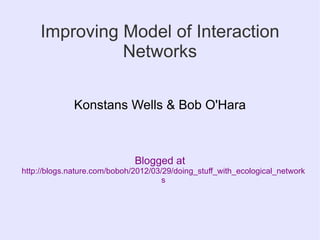
Interaction networks
- 1. Improving Model of Interaction Networks Konstans Wells & Bob O'Hara Blogged at http://blogs.nature.com/boboh/2012/03/29/doing_stuff_with_ecological_network s
- 2. Typical Data Fi lu Fi th Pr af Fi su Ma bu Commom Bulbul 128 110 70 30 27 Blue Monkey 19 35 2 28 36 Red tailed Monkey 11 19 0 52 29 Voilet backed starling 1 0 190 0 0 Blackcap 64 23 3 8 9 http://www.nceas.ucsb.edu/interactionweb/html/schleuning-et-al-2010.html
- 3. What's wrong? Network statistics are messy Q= 1 ( ki k j ) ∑ Aij − 2m δ(c i , c j ) 2m i , j Derived for known networks behaviour when uncertain is difficult to understand
- 4. Statistical Problems How do we estimate sampling error? Are the zeroes real? What if the sampling is not representative?
- 5. A Better Approach Model the data
- 6. Building the Model I Fi lu Fi th Pr af Fi su Ma bu Common Bulbul 1 λ11 λ21 λ131 λ41 λ51 Common Bulbul 2 λ12 λ22 λ132 λ42 λ52 Red tailed Monkey 1 λ13 λ23 λ33 λ43 λ53 Red tailed Monkey 2 λ14 λ24 λ34 λ44 λ54 Red tailed Monkey 3 λ15 λ25 λ35 λ45 λ55 Start with mean rates of interaction per individual
- 7. Building the Model II Fi lu Fi th Pr af Fi su Ma bu Common Bulbul 1 λ11 λ21 λ131 λ41 λ51 Common Bulbul 2 λ12 λ22 λ132 λ42 λ52 Red tailed Monkey 1 λ13 λ23 λ33 0 λ53 Red tailed Monkey 2 λ14 0 λ34 λ44 λ54 Red tailed Monkey 3 λ15 λ25 λ35 λ45 λ55 Can set some means to zero
- 8. What is λij? Individual rate of visitation No. of visits ~ Poisson(λij) We can model this further
- 9. Individual To Species Species-level rate of interaction is Λc ,r= ∑ ̄ λ i , j =nc m r λ c , r i , j ∈c , r
- 10. Individual To Species Species-level rate of interaction is Λc ,r= ∑ ̄ λ i , j =nc m r λ c , r i , j ∈c , r Abundances of resource & consumer
- 11. Individual To Species Species-level rate of interaction is Λc ,r= ∑ ̄ λ i , j =nc m r λ c , r i , j ∈c , r Abundances of Mean individual- resource & level consumer preferences Extracts abundance effects from preferences
- 12. In practice... We might observe trees, and not be able to distinguish individuals visiting them We have several resources, but lump consumers together nc = 1 If we estimate nc, we can get back to λij
- 13. Further modelling Log-linear: log(λ ij )=β(r i , c j )+ γ (i , j) β(r i , c j )=ρ(r i )+ χ (c j )+ ι (r i , c j ) Resource + Species + Interaction Separates out “palatability” and “hungriness” from specificity
- 14. Better Measures Modularity Q= 1 2m i , j ( ki k j ) 1 ∑ A ij − 2m δ(ci , c j )= 2 ∑ ( pij − pi⋅ p⋅j ) δ(c i , c j ) i, j “the fraction of edges that fall within communities minus the expected value of the same quantity if edges are assigned at random, conditional on the given community memberships and the degrees of vertices.” But logit p ij −logit pi⋅ p⋅j =ι (r i , c j )
- 15. Fitting the Model Simplest: log-linear model glm(Count ~ Resource*Consumer, family=poisson()) Assumes no over-dispersion Can model further, e.g. add resource-specific covariates
- 16. More complicated models If we have several individuals of resource and consumer: glm(Count ~ Resource*Consumer + Res.Ind*Con.Ind + offset(Time), family=poisson() Now Res.Ind:Con.Ind is over-dispersion Could use random effects
- 17. Adding Zeroes Where the data is a 0, λij is estimated as low Can't tell where the “true” zeroes are So, use a zero-inflated Poisson distribution adds zeroes But they are uncertain
- 18. How well does our model perform? Simulation study 12 resource species, 9 consumers Effects: Each cell a 3 x 3 matrix Generalist Opportunist Specialist Generalist 0.75 0.25 0 Opportunist 0.2 0.01 0 Specialist 0.01 0 0.2 Erratic 0.05 0.01 0
- 19. Sample Sizes Balanced: 3,5,10,15,20 individuals of each species Unbalanced: 5 individuals of each resource species 5, 10, 15, 20 individuals of generalist consumers 3 individuals of other consumers
- 20. Balanced Results
- 22. Thoughts Model links more closely to actual mechanisms more interpretable Can build models for specific questions modularity Can build hierarchical models, to combine several networks meta-regression
- 23. What More? You tell us
Hinweis der Redaktion
- Agent-based interaction models: estimating per individual interaction strength and covariates before simplifying data into per species ecological networks
